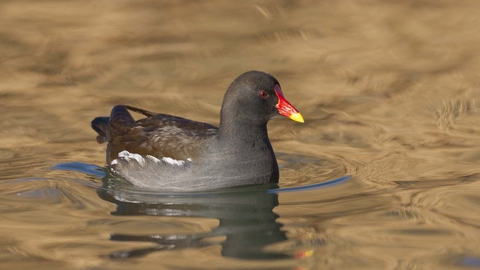
©Guy Edwardes/2020VISION
Moorhen
Scientific name: Gallinula chloropus
A familiar black bird of our lakes, ponds and rivers, the moorhen is widespread; look out for its large and untidy-looking nest on the water in spring. It can be distinguished from the similar coot by its yellow legs, red beak and the white patches on its body.
Top facts
Category
Stats
Length: 31-35cmWingspan: 52cm
Weight: 320g
Average lifespan: 3 years
Conservation status
Common. Classified in the UK as Amber under the Birds of Conservation Concern 5: the Red List for Birds (2021). Protected in the UK under the Wildlife and Countryside Act, 1981.
When to see
January to DecemberAbout
A familiar bird of our wetlands, the moorhen is often seen on park lakes, ponds and rivers. It spends more of its time out of the water than its relative, the coot, and even climbs trees. Moorhens are omnivores, eating everything from snails and insects to small fish and berries. When disturbed, it usually takes cover in nearby vegetation, but if it does take to the air, its flight is short and laboured. The moorhen offers a great opportunity to watch breeding bird behaviour: in the spring, the male swims towards the female with its bill in the water and the two birds eventually nibble at each other's feathers; both birds then build the nest out of twigs in emergent vegetation and defend it with ferocity.What to look for
The moorhen can be distinguished from the similar-looking coot by its olive-black back (separated from its blue-black body by a white line), the white patches under its tail, and its red bill, which has a yellow tip.Where to find
Widespread across town and countryside, but scarcer in upland areas.Habitats
Did you know?
Moorhens are one of the world's commonest birds and can be found right around the globe, going by different names such as 'skitty coot', 'marsh hen' and 'common gallinule'.Watch
Moorhen by John Bridges
